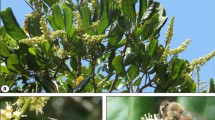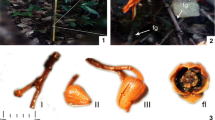Abstract
Flowers of Asteraceae have conspicuous features that are important at the tribal level, such as the branches of the style, pappus, shape of the corolla, and anthers. The floral ontogeny of ten Brazilian weed species of Asteraceae was performed for Conyza bonariensis L., Cosmos sulphureus Cav., Eclipta alba L., Elephantopus mollis Kunth, Emilia sonchifolia L. DC., Galinsoga quadriradiata Ruiz and Pav., Erechtites valerianifolius (Link ex Spreng) DC., Parthenium hysterophorus L. Praxelis clematidea R. M. King and H. Rob, and Sigesbeckia orientalis L. in order to describe the morpho-anatomy, ontogenetic steps, and identify features that may support the tribeal classification. Flowers and buds were fixed in glutaraldehyde, embedded in historesin, and sectioned with a rotary microtome. Sections were stained with Toluidine Blue. The inflorescence can be heterogamous or homogamous; the pappus is absent or persistent; the corolla is tubular or ligulate; anthers have an apical appendage which is obtuse or acute; and some anatomical features are the ovary usually trapezoidal-shaped; the pappus either vascularized or not; the corolla with possible secretory structures, only two species do not show twin hair on the outer ovary epidermis;and ovarian mesophyll usually composed of two or three regions. In general, the species analyzed show several similar features, such as the anther structure, pappus, and stigma. A distinct feature was observed among the species: the absence of pappus, and twin hairs in three species: E. alba (Heliantheae tribe), P. hysterophorus (Heliantheae tribe), and S. orientalis (Millerieae tribe), all belonging to “Helliantheae Alliance” clade.







Similar content being viewed by others
References
Bremer K (ed) (1994) Asteraceae: cladistics and classification. Timber Press, Portland
Dadpour MR, Naghiloo S, Neycharam SF (2012) The development of pistillate and perfect florets in Xeranthemum squarrosum (Asteraceae). Plant Biol 14:234–243
Dahlgren G (1991) Steps toward a natural system of the dicotyledons: embryological characters. Aliso 13:107–165
Davis GL (1966) Systematic embryology of the angiosperms. Wiley, New York
Deng Y, Chen S, Teng N, Chen F, Li F, Song A, Guan Z (2010) Flower morphologic anatomy and embryological features in Chrysanthemum multicale. Sci Hortic 24:500–505
Douglas GE (1944) The inferior ovary. Bot Rev 10:125–186
Endress PK (1994) Diversity and evolutionary biology of tropical flowers. Cambridge University Press, Cambridge
Funk VA, Susanna A, Stuessy TF, Robinson H (2009) Classification of Compositae. In: Funk VA, Susanna A, Stuessy TF, Bayer RJ (eds) Systematics, evolution, and biogeography of Compositae. Smithsonian Institution, Washington, DC, pp 89–99
Galastri NA, Oliveira DMT (2010) Morfoanatomia e ontogênese do fruto e semente de Vernonia platensis (Spreng.) Less. Asteraceae. Acta Bot Bras 24:73–83
Guerrits PO (1991) The application of glycol methacrylate in histotechnology; some fundamental principles. University Groningen, Groningen
Harris EM (1999) Capitula in the Asteridae: a widespread and varied phenomenon. Bot Rev 65:348–369
Horner HT Jr (1977) A comparative light- and electron microscopic study of microsporogenesis in male-fertile and cytoplasmic male-sterile sunflower (Helianthus annuus). Am J Bot 64:745–759
Judd WS, Campbell CS, Kellogg EA, Stevens PF, Donoghue MJ (2002) Plant systematics—a phylogenetic approach, 2nd edn. Sinauer Associates, Sunderland
Julio PGS, Oliveira DMT (2009) Morfoanatomia comparada e ontogênese do pericarpo de Bidens gardneri Baker e B. pilosa L. (Asteraceae). Revista Brasileira de Botânica 32:109–116
Katinas L, Hernandes MP, Arambarri AM, Kunk VA (2016) The origin of the bifurcating style in Asteraceae (Compositae). Ann Bot 117:1009–1021
Lersten NR, Curtis JD (1990) Invasive tapetum and tricelled pollen in Ambrosia trifida (Asteraceae, tribe Heliantheae). Plant Syst Evol 169:237–243
Lewinsohn TM (1991) The geographical distribution of plant latex. Chemoecology 2:64–68
Marzinek J, Oliveira DMT (2010) Structure and ontogeny of the pericarp of six Eupatorieae (Asteraceae) with ecological and taxonomic considerations. Anais da Academia Brasileira de Ciências 82:279–291
Mukherjee SK, Nordenstam B (2008) Diversity of pappus structure in some tribes of the Asteraceae. Phytotaxonomy 8:32–46
O’Brien TP, Feder N, McCully ME (1964) Polychromatic staining of plant cell walls by toluidine blue O. Protoplasma 59:368–373
Pallone SF, Souza L (2014) Pappus and cipsela ontogeny in Asteraceae: structure considerations of the tribal category. Revista Mexicana de Biodiversidad 85:62–77
Pandey AK, Singh RP (1980) Development and structure of seeds and fruits in tribe Vernonieae—some Vernonia and Elephantopus species. Flora 169:443–452
Radosevich S, Holt J, Ghersa C (1997) Weed ecology, 2nd edn. Wiley, New York
Robinson H (1981) A revision of the tribal and subtribal limits of the Heliantheae (Asteraceae). Smithson Contrib Bot 51:1–102
Robinson H (1983) A generic review of the tribe Liabeae (Asteraceae). In: Funk VA, Susanna A, Stuessy TF, Bayer RJ (eds) Systematics, evolution, and biogeography of Compositae. Smithsonian Institution, Washington, DC, pp 89–99
Robinson H (2009) An introduction to micro-characters of Compositae. In: Funk VA, Susanna A, Stuessy TF, Bayer RJ (eds) Systematics, evolution, and biogeography of Compositae. Smithsonian Institution, Washington, DC, pp 89–99
Roth I (1977) Fruits of angiosperms. Handbuch der Pflanzenanatomie. Lubrecht & Cramer Ltd, Berlin
Stuessy TF, Spooner DM (1988) The adaptative and phylogenetic significance of receptacular bracts in the Compositae. Taxon 37:114–126
Weberling F (1992) Morphology of flowers and inflorescences. Cambridge University Press, Cambridge
Acknowledgments
We thank CAPES (Coordenação de Aperfeiçoamento de Pessoal de Nível Superior, Brazil) and CNPq (Conselho Nacional de Desenvolvimento Científico e Tecnológico, Brazil) for the support granted for the accomplishment of this study.
Author information
Authors and Affiliations
Corresponding author
Rights and permissions
About this article
Cite this article
Batista, M.F., De Souza, L.A. Flower structure in ten Asteraceae species: considerations about the importance of morpho-anatomical features at species and tribal level. Braz. J. Bot 40, 265–279 (2017). https://doi.org/10.1007/s40415-016-0312-9
Received:
Accepted:
Published:
Issue Date:
DOI: https://doi.org/10.1007/s40415-016-0312-9




